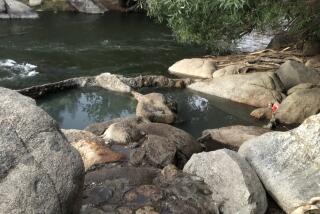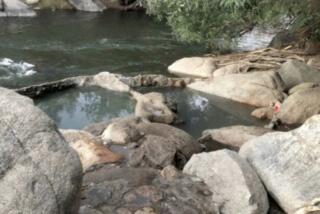Soakers beware: Those hot tub warnings may be overstated
- Share via
After a long day of skiing, I found it impossible to say “no” when my kids begged for some time in the hotel hot tub -- I was looking forward to the experience as much as they were. But when we reached the tub, we found a sign with these warnings:
“The hot tub is not recommended for children under the age of 5. The following individuals should consult with their physicians before using the hot tub: the elderly, individuals with heart disease, diabetes, or high blood pressure, pregnant women, and anyone taking prescription medications.”
Who could feel safe in the tub after reading that?
Such signs are everywhere: at the supermarket, where we’re advised that fish may contain dangerous levels of cancer-causing chemicals; at the gas station, where we’re told that prolonged exposure to gasoline fumes could cause cancer; even at fast-food restaurants, where we’re warned about the dangers of hot coffee.
Although those signs are ostensibly there to protect us, many people assume that the risks are overstated. Some even choose to ignore them. “They might as well not be there,” says Los Angeles resident Larry Jacobson. “They certainly don’t impact my behavior.”
When it comes to hot tub warnings, that assumption may be correct: The evidence behind many of them is sketchy at best.
The scientific research focuses primarily on infectious diseases that can be transmitted from one bather to another. For example, high levels of the bacteria Pseudomonas aeruginosa can build up in hot tubs -- particularly ones that are not well maintained or properly disinfected -- leading to skin infections and rashes. Although the rashes typically are mild and require no treatment, more severe symptoms (fever, muscle and joint pain, fatigue) can develop.
For other conditions, the rationale behind the warnings appears to be primarily theoretical.
It’s true that immersion in hot water causes blood vessels throughout the skin to dilate, or open up, which can lead to a drop in blood pressure and an increased heart rate. In someone with heart disease, or someone who is very old, this rapid drop in blood pressure or increase in heart rate could -- theoretically -- trigger a heart attack. However, little proof exists that soaking in a hot tub actually causes this to occur.
For pregnant women, the fears are based on the fact that women who have a fever during pregnancy have a higher risk of delivering babies with malformations. Because prolonged soaking in a hot tub can raise the body temperature, there may be some basis for concern.
Researchers have published only two studies on this. One found that hot tub exposure early in pregnancy was associated with an increased risk of neural tube defects such as spina bifida; the other -- published two months ago -- showed that hot tub use in early pregnancy may increase the risk of miscarriage almost twofold.
The biggest worries about children in hot tubs involve overheating and drowning. In its book “Caring for Your Baby and Young Child: Birth to Age 5,” the American Academy of Pediatrics clearly states its position on hot tubs: Don’t allow young children to use them.
In children, too, concerns about overheating may be more theoretical than real. Children will absorb more heat soaking in a hot tub than adults, and dangerous elevations in body temperature could potentially develop (the younger the child, the greater the risk). But evidence that these changes actually take place and endanger children is scarce.The risk of drowning, on the other hand, is real. Children can drown in as little as a few inches of water, and every year several do. No child of any age should ever use a hot tub unless supervised by an adult. Perhaps the greatest drowning danger arises when a child climbs unnoticed into an unsecured tub.
For this reason, hot tubs are a constant source of danger. They should be properly fenced or covered, and an open tub should never be left unattended by an adult -- even for a few seconds.
Although not all the rules posted by the sides of hot tubs hold up to scientific scrutiny, some just make good sense: Don’t use the hot tub alone; children must always be supervised by an adult; don’t use the hot tub if you are under the influence of alcohol or drugs, which can cause drowsiness; check the water temperature before entering (it should not exceed 104 degrees); observe reasonable time limits (10 to 15 minutes); enter and exit the tub slowly.
At the hotel, as we stood by the hot tub shivering, I quickly decided we would proceed as planned. Ten minutes in the hot water felt great -- but the chill I got climbing out merited its own warning.
*
Dr. Valerie Ulene is a board-certified specialist in preventive medicine practicing in Los Angeles. The M.D. appears the first Monday of the month.






